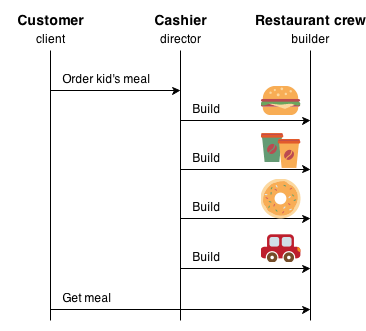- 1. The reasons
- 2. Problems
- 3. Structure
- 4. Example
- 5. Control List
- 6. Rules of thumb
The reasons
- Separating the construction of a complex object from its representation so that the same construction process can create different representations.
- Dismantling a complex representation, creating one goal from several variations.
Problems
Separation of the object interpretation algorithm (for example, document parsing) from the mechanism for saving the object's ready state. For example, building a more complex or different target object from an RTF file, such as ASCII text, TeX, a text widget. The focus is on the creation of complex aggregates.
The "Director" calls the "Builder" service because it interprets the external format. The "builder" creates a part of the complex object each time it is called and maintains all intermediate states. When the product is completed, the client receives the result from the "builder".
Provides finer control over the construction process of an object. Unlike creation patterns, which build products in a single call, the Builder pattern sequentially builds a product under the control of a "Director".
Structure
Reader encapsulates the parsing of input information. And the Builder allows polymorphic creation of many unique views or targets.

Example
The Builder pattern separates the construction of a complex object from its representation, so that the same construction process can create different representations. Let's take a children's food restaurant as an example. In this case, this template is used as follows. Baby food usually consists of a main item, an item, a drink, and a toy (eg, a hamburger, a potato, a coke, and a toy dinosaur). Please note that there may be changes in the content of baby food, but the construction process will remain the same. Whether the customer orders a hamburger, cheeseburger, or chicken, the process is the same. The employee at the counter directs the order to collect the main item, the side item, and the toy. These items are then placed in a bag. The drink is placed in a cup and left behind the bag. The same process is used in other restaurants.

Control List
- Decide if the problem is a problem with a common data input and multiple possible views (or outputs).
- Encapsulate the parsing of the common input in a Reader class.
- Create a standard protocol for creating all possible output representations. Capture the steps of this protocol in Interface Builder.
- Define a Builder derived class for each target view.
- The client creates a Reader object and a Builder object and registers the latter with the former.
- Client asks Reader to "build".
- The client asks the Builder to return a result.
Rules of thumb
- Sometimes the creation patterns complement each other: the Builder may use one of the other patterns to implement the components to be created. Abstract Factory, Builder and Prototype can use Singleton in their implementations.
- Builder focuses on building a complex object step by step. An abstract factory emphasizes a family of objects (simple or complex). The Builder returns the product as the last step, but as far as the abstract factory is concerned, the product returns immediately.
- Builder often creates a Composite.
- Often projects start with Factory Method (less complex, customizable, subclasses proliferate) and evolve towards Abstract Factory, Prototype, or Builder (more flexible, more complex) as the developer finds more flexibility is needed.
